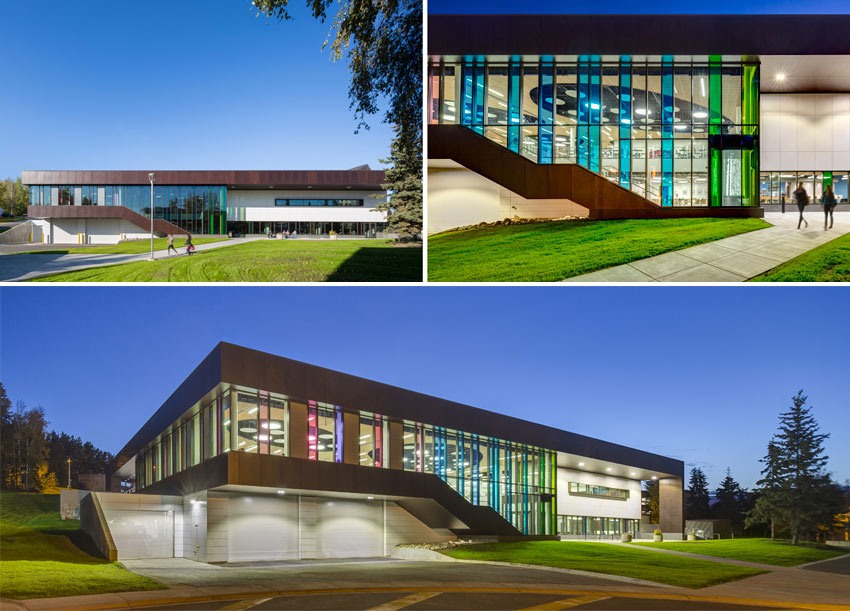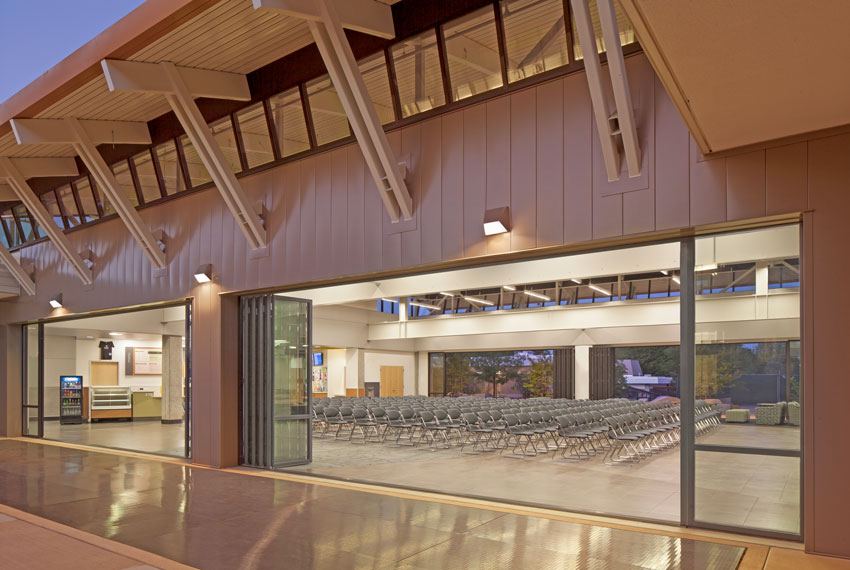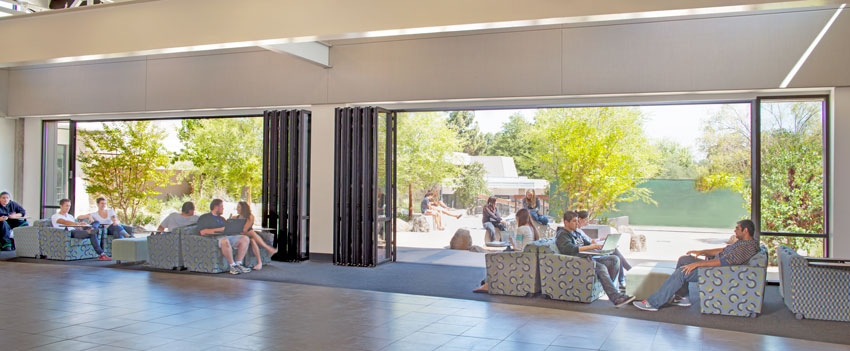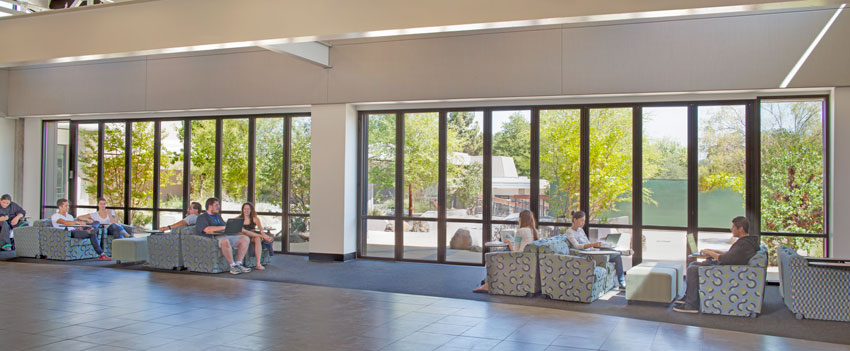State-of-the-Art Design in Higher Education
Taking on the challenges of modern university facilities
![]() Continuing Education
Continuing Education
Use the following learning objectives to focus your study while reading this month’s Continuing Education article.
Learning Objectives - After reading this article, you will be able to:
- Identify and recognize the design and performance aspects of glass and glazing as part of an energy-efficient, comfortable, and code-compliant building exterior.
- Assess the health and safety aspects of wall surfaces as they relate to durability and sustainability.
- Explain the significance of providing flexible spaces in university and college settings for general well-being, functionality, and energy performance.
- Determine ways to incorporate the health, safety, and welfare principles discussed as shown in case studies
Higher-education facilities provide some unique challenges for designers due to the multiplicity of design criteria and the variability of the ways different buildings are used on a college campus. Academic buildings, for example, have different needs from residential ones, which are still different from laboratory, administrative, and athletic ones. Of course, all higher-education buildings have to provide appropriate security, be durable over the long term, remain functional 24/7 in many cases, and offer access to modern and changing technologies. From a design standpoint, higher-education facilities have allowed architects to create some excellent architecture even while sometimes being required to fit in with a predetermined campus aesthetic.
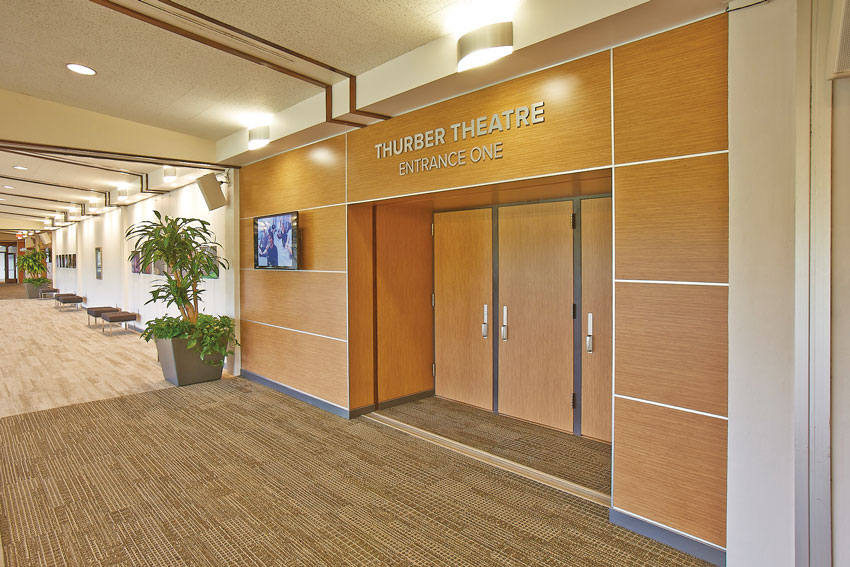
Photo courtesy of Inpro
Colleges and universities are places of innovation and creativity but need to operate pragmatically and cost effectively over time too. Architects and other design professionals are tasked with finding the balance through design, as shown here at the Ohio State University, Department of Theater, Drake Performance Center.
How can architects stay ahead of the curve on all of this diversity at universities and colleges? One place to start is by looking at some of the particular aspects of exterior and interior design that can be used in many of these different settings to meet the various design criteria. In this course, we will look at some of those aspects for some of the most current thoughts and design techniques for successful higher-education designs.
Exterior Design Incorporating Glass
While creativity is clearly and appropriately embraced in higher-education design, fiscal responsibility and functionality are also very strongly required. This is especially true since the college or university will typically not only oversee the design and construction of their buildings but will also be responsible for the long-term operation and maintenance of those buildings. Typically, the capital improvements budget is different and separate from the operations and maintenance budgets, but the truly enlightened campus staff will see the obvious connection between the two. Regardless, it is the role of the architect and design team to find the proper balance between creative design, functionality, and overall budget-conscious high performance. This is true whether the focus is new construction or renovation and applies regardless of building use.
Glass in Design
One of the most visible places to begin looking at this balance is the exterior facade of a higher-education building. Aesthetics will quickly be influenced by the building function, the surrounding buildings, material preferences, and the creative talent of the design team. Performance issues will be addressed first in opaque wall areas through the makeup and integration of the needed thermal, water, air, and vapor barriers. Then, the use of glass and glazing often becomes the focus of considerable design effort both in terms of appearance and energy efficiency.
Most architects are by now familiar with the fact that multiple independent studies have demonstrated the benefits of natural daylighting in learning situations. In particular, LEED rating systems for schools and other similar programs have been structured around evidence that students perform better when they have access to views and daylighting. The same is true in higher-education settings, so architects are looking for the right arrangements of glass that provide the best daylighting while still working within the overall design intent and performance requirements. This usually requires different iterations or different design concepts to select, model, assess, analyze, and then finalize a glazing layout that balances all design requirements while still staying on budget.
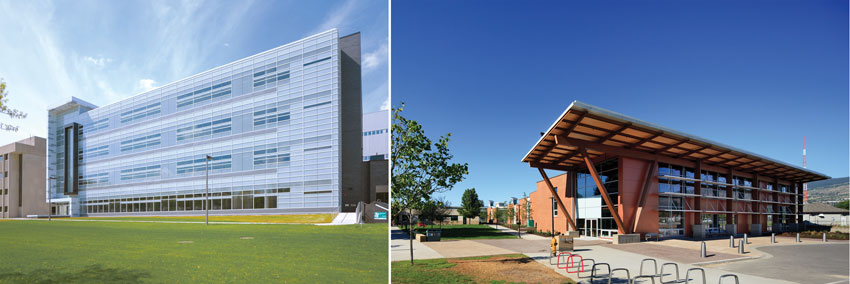
Left: © Christopher Lark; Right: © Ed White
Glass and glazing are integral parts of the design and performance of all types of higher-education buildings, such as the Michigan State University Bioengineering Facility (left) in East Lansing, Michigan, designed by Integrated Design Solutions and the Pattison Centre of Excellence at Okanagan College (right) in Kelowna, British Columbia, designed by CEI Architecture.
Glass Performance
In order to determine the overall performance of different design concepts for a facade, architects need to know the performance data for different types and specifications of glass. In the past three or four decades, the variety of glass options for appearance, energy performance, safety, and security have grown notably, so there is a full palette of choices for designers to consider. Further, the use of double- and triple-paned insulating glass units (IGUs) has become common with the option of treating each surface of each pane differently or even making them out of different types of glass. For example, an IGU makeup may be selected for energy efficiency, but the outer most pane may be laminated glass that has superior sound-deadening and shatter-resistant properties. The inner pane(s) may then be clear or color tinted with coatings to further enhance energy performance. It is quite logical then, given the range of variations and possibilities, to request assistance from glass manufacturers in summarizing, analyzing, and comparing different glass makeups against the energy and performance needs of a particular project.
IGUs consist of two or three layers of glass separated by spacers in between them around the perimeter. The resulting air gap(s) between the panes of glass provides the insulating layer that slows down heat loss, keeps the inside glass surface warmer, and reduces the opportunity for condensation to form on the glass surfaces. From there, specific coatings and tints can be incorporated to create high-performance double- or triple-paned units. Some can be selected to control visible light and glare by reducing the amount of light that passes through the glass. Others can reflect the amount of unwanted solar heat gain (think warm months or warmer climates) or reduce heat loss (colder time of year or colder climates) as may be appropriate for the building.
While high-performance double glazing is common, the use of triple-paned IGUs is becoming more common for college and university buildings in cold climates. This is because, after all of the assessment and analysis is done, it makes sense to add the extra pane of glass when looking at the big picture. The lifetime of campus buildings could easily span 50 years and, in most cases, much longer. A simple life-cycle assessment of high-performance triple glazing over the long haul can demonstrate reduced energy costs, greater comfort for those near the glazing, and a favorable payback. Further, universities commonly want to be seen on the cutting edge in the use of energy conservation measures, leading by example for the students while being as economical as possible. In addition to the multiple energy performance factors that triple glazing offers today’s buildings, another physical layer of glass provides superior noise reduction compared to a standard double-glazed unit.
When architects are considering the use of either double- or triple-glazed high-performance insulated glass units, several factors need to be considered:
- Overall U-factor: Calculating and testing the U-factor of an IGU is based on many details. First is the size of the air space, generally with larger being better up to a point. Second is the type of spacer used since it will affect the U-factor around the perimeter of an IGU. A “warm edge spacer” is typically made from a combination of materials (e.g., composite and thermally broken stainless steel) with low heat conductivity instead of a lower-performing aluminum spacer. The assembly of the IGU around its perimeter and the materials used to seal it together can similarly make a difference. This combination of all these fundamental components of the IGU plays a huge role in determining the “overall U-factor,” which is much more important than just the simple “center of the glass” U-factor that doesn’t tell the whole story.
- Perimeter sealant: The sealant around the perimeter of the IGU is the key to preserve the high performance of IGUs over time. If the seal fails, then the performance decreases and moisture may collect between the panes. In time, that moisture can cause permanent discoloration of the glass, and it would then need to be replaced. The sealant strength also contributes to the overall strength of the IGU; therefore, it is best to always coordinate with the window manufacturer to ensure the compatibility of the sealant with the IGU and the glazing framing.
- Performance enhancements: Once the basics of the IGU are determined, then the choices rely on several things that can enhance performance further. First is the gas that fills the spaces between the panes of glass. Common choices are ordinary air or inert gases, such as argon or krypton. Then manufacturers can apply high-performance coatings to different glass surfaces to control solar heat gain and enhance insulating value. Low emissivity (low-e) coatings are one example that are very effective at improving U-factors, but they also influence the color of the glass, so understanding the range of options here is worthwhile. In much of North America, neutral-colored coated glass is a popular product for education projects. With a high visible light transmission, it delivers abundant natural light for daylighting and views. When used in a triple-glazed IGU with argon, for example, the U-factor is cut almost in half compared to double-pane uncoated glass, making it an excellent high-performance choice for colleges and universities in northern regions. Such high-performance glass can help higher-education facilities earn LEED and other green building standard designations.
- Coordination with frames: The size and strength of the frame material must be sufficient to accommodate the thickness of, and withstand the weight of, double or triple glazing units. A thermally broken aluminum window frame is often used due to its durability, noncorrosiveness, and better thermal performance. However, the location of the thermal break and the profile of how the glass, thermal break, and aluminum frame all work together needs to be looked at and assessed.
All of the above details can be specified by architects but need to be coordinated with those who actually produce the glass products. To get a manufacturer’s perspective on the state of the glass industry, here’s what Brian Schulz, product manager at Guardian Glass North America,k has to say: “Glass is a critical and complicated material. The building team has to manage daylight, aesthetics, glare, and energy savings while considering climate, elevation, and other performance and environmental factors.” Regarding the increasing use of triple glazing, he points out, “Triple-glazed glass is one of many product combinations available to architects creating the most innovative and energy-efficient higher-education buildings.” And when asked about where the industry is going, he says, “The future of glass is all about adaptability, flexibility, and its long-term capability to remain beautiful but tunable to the environment. We want to identify opportunities and develop products and technologies that create value for designers, contractors, and building owners.”
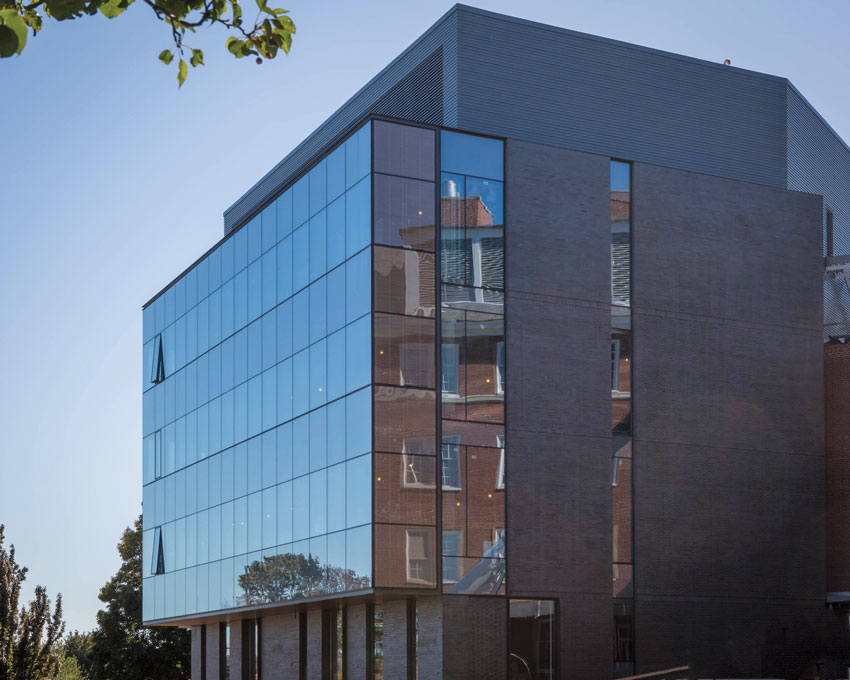
Photo courtesy of Guardian Glass/© JeffAdamsPhoto.com
The Tufts University Science & Engineering Complex designed by the architectural firm Payette uses clear, triple-glazed, insulating glass with neutral coatings to achieve the balance between aesthetics and performance needed for its New England climate.
Designing For Flexible Facades and Spaces
One of the most common requests of the staff and faculty who actually use higher-education spaces is the desire for flexible spaces. What they are usually asking for is the ability to accommodate different size groups in a space or to connect adjacent spaces together. This connection can be made between two interior spaces or between indoor and outdoor spaces. While this all seems reasonable and logical, achieving it often means that the exterior facade has to take on a new dimension. Specifically, it needs to be operable or transformable, essentially allowing the free passage of people, air, light, and activity between indoors and outdoors when required, but be capable of closing up to be weathertight when desired.
A common solution to achieve this connectivity between spaces, particularly indoor/ outdoor spaces, is the use of opening glass walls. These are comprised of individual, full-height panels of glass that are framed in either wood, aluminum, or a combination of both. The glass and frames can be selected to meet the same or different criteria as the rest of the building exterior. The means of operation can be based either on panels that fold (accordion style, off to one or both sides) or on sliding panels that stack or disappear into a wall recess. Either way, the effect is the same—full connectivity between spaces when open and full physical separation when closed, with controlled daylight and views possible in either condition. Creating spaces this way, filled with light and infused with the sense of openness and transparency, exemplifies a spirit of contemporary education and architecture. The resulting designs are more open, creating a shared use of space with brighter interiors and seamless transitions between indoors and outdoors. Moreover, with square footage often at a premium, the opening glass wall allows space to be utilized efficiently with potentially smaller footprints for some areas.
When it comes to using opening glass walls on a college or university campus, there are some other very good reasons to consider them beyond the space flexibility desire. Opening glass walls have been used by designers as a key ingredient for 21st century learning spaces to provide abundant fresh air ventilation and natural daylighting while providing acoustical buffering when needed. This enhances the well-being of the people inside since students and faculty typically spend 85 to 90 percent of their time indoors and the concentration of pollutants indoors is commonly higher than outdoors. Opening glass walls allow the interior spaces to be flushed with fresh air thus removing pollutants and creating a more invigorating indoor environment. When closed, the acoustic separation allows for better concentration, less noise distraction, and better intelligibility of the sound within the space.
Based on their multiple space, health, and environmental attributes, the use of operable glass walls on a college or university campus is suitable to many different building types. Some of the most common ones are discussed as follows.
- Academic buildings: Opening glass walls provide abundant natural daylight whether they are open or closed. Studies have shown that students with limited classroom daylight were outperformed by those with abundant natural light by 20 percent in math and 26 percent on reading tests. Hence, opening glass walls can help create a demonstrably better learning environment that is appreciated by students and professors alike.
- Auditoriums and multipurpose facilities: Exterior opening glass walls in multipurpose facilities are a natural fit. They can easily be configured to provide expanded event space and indoor/outdoor access for classes, lectures, speakers, performances, and special events. Quickly opened or closed, they deliver unobstructed access into the space, helping to accommodate larger events. The large openings also allow for easy movement of large objects, such as staging, tables, and chairs. The large glass panels provide generous natural daylight, fresh air ventilation when open, and an energy-efficient sound barrier to the outside when closed. During high-traffic events (e.g., class registration or event start and finish), the opening glass walls allow for the free flow of people through wide openings. During low-traffic times or when the system is closed, a single swing door can handle traffic flow while maintaining energy efficiency.

Photos courtesy of NanaWall Systems
Connecting interior spaces can be controlled with opening glass walls to allow full access during high-traffic times or limited access with a traditional swing door panel in lower-traffic times.
- College campus student spaces: Modern campuses are emulating the hospitality industry by creating areas where students can meet, work together, converse, or just hang out. Opening glass walls join multiple areas together to facilitate these activities or can conversely be used to separate out smaller groups when needed.
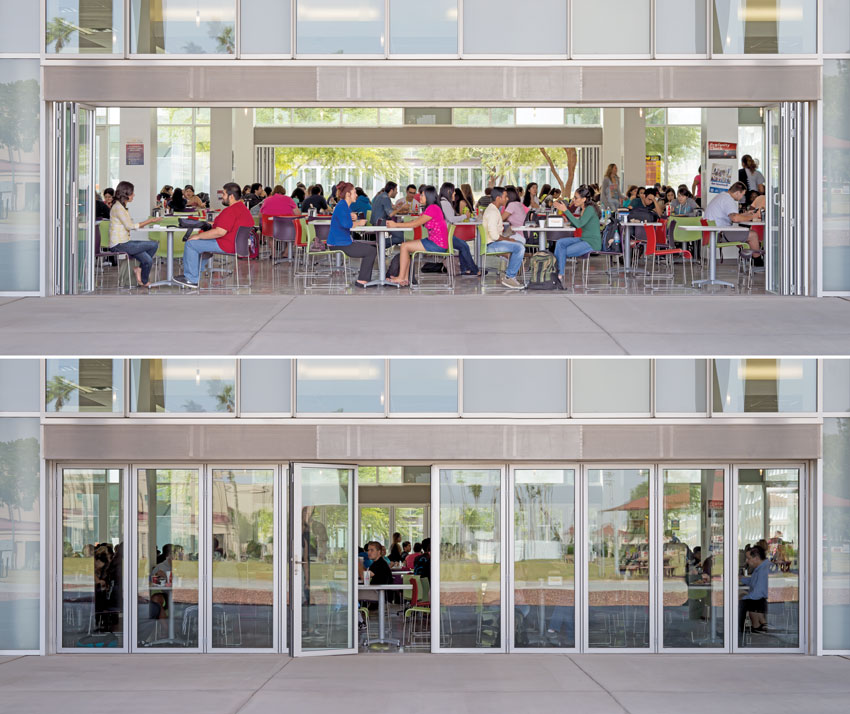
Photos courtesy of NanaWall Systems
Opening glass walls allow for a seamless transition in the building facade between indoor and outdoor spaces when open and a weathertight seal when closed, as shown here at Arizona Western College in Yuma, Arizona.
- Cafeterias/food service facilities: Creating a great student dining and socializing experience can be enhanced with wide-open entryways to the cafeteria area. A large opening encourages students to easily enter (or exit) and find their classmates. The benefits of the large glass panels include fresh air and natural daylight with the corresponding potential for reduced heating, cooling, and lighting costs—particularly during off-peak times when the space has low occupancy. Outdoor connected food service spaces can easily be converted from open to closed due to a change in the weather since even large operable glass panels can be quickly and easily moved by a staff member.
- Libraries: In libraries, opening glass walls can be used to manage interior space and for sound buffering by partitioning off rooms that have higher activity or sound levels at times. As exterior applications, they can allow for gardens and courtyards to be connected to the interior while allowing natural daylight and fresh air to flow throughout the space.
- Campus natatoriums: Indoor pools can become loud, and the air oppressively heavy. Incorporating an opening glass wall allows fresh air ventilation, relief from sound reverberation, and creates a less closed-in space.
- College sports venues: Many college sports stadiums are creating choices in seating types from open outdoor bleachers to private, enclosed boxes and different levels in between. Using an opening glass wall system in front of a box seating area provides the further option of having a protected seating area or one that is fully open when the weather is favorable. Either way, it maintains an unobstructed view in addition to protecting the seats from the outside elements in the offseason.

Photos courtesy of NanaWall Systems
Sports stadiums and arenas on college campuses that seek to provide protected box seating areas use opening glass walls that move based on weather conditions, such as this one at Boise State University in Idaho.
Overall, the use of opening glass walls can achieve a lot of design and operation goals for college and university buildings. Architects can work with manufacturers to maximize their usefulness and functionality while keeping costs in line with the budget.
Interiors Incorporating Best Practices
Turning from building exteriors to interiors, the design challenges and requirements for higher-education buildings are similar. Aesthetics, creativity, functionality, durability, cost effectiveness, and performance all need to be embodied in the design and construction of the many and varied types of interior rooms and spaces in college and university settings. Getting there not only involves effective planning and design, but it also requires an understanding of different types of materials and products that can be used effectively and innovatively. We will look at three areas where this approach can be utilized to create the most up-to-date spaces and facilities.
Wall Panel Systems
Interior surfaces often need to function in a variety of ways, such as having a professional appearance and being durable enough to hold up over time from a lot of use by different people. One way that this is being achieved is through the use of prefinished wall panel systems that are available in a variety of finishes and mounting systems. Often available as a family of products from manufacturers, these systems can offer wood-grained or other attractive appearances, long-term durability due to the innovative materials used, and even a Class A fire rating.
Images courtesy of Inpro
Innovative, durable wall panel systems can be used to provide wood-grained or other surface treatments, including (from left) white boards, tackable fabric panels, and custom printed panels with art or graphics.
Of particular interest in college and university settings, wall panel systems can be customized to provide a variety of functional features. For example, white board panels, in magnetic or nonmagnetic versions, can be incorporated into the wall to provide a writing surface, projection plane, or other uses for communication and teaching. Alternatively, a tackable fabric panel can be incorporated to elegantly replace random-sized bulletin boards or just provide a soft, acoustic, wall covering. For full customization, it is also possible to provide a solid panel with customized, printed graphics to assist in wayfinding, branding of a building or institution, or simply to provide a visual accent. Some popular choices for printed panels in colleges and universities are team mascots, sports logos, or university seals. These can all be incorporated easily into an overall system for innovative and customized interiors.
A key element of any interior panel system is the means to install them. In some cases, a square edge panel is used that can be field cut and custom fit into several types of aluminum frame components that are mounted directly to the wall substrate. Flush trim systems are designed to align with the surface face of the panels and cover them with J-trim pieces, top caps, dividers, and corner pieces for inside and outside corners. Alternatively, the trim can be used to create a more three dimensional wall appearance with wide, recessed, reveal pieces of trim that frame each panel separately with corner, divider, and top cap profiles in aluminum. If the aluminum trim approach isn’t sought, then three-dimensional pieces that match or contrast with the wood finish of the panels can be used that emulate the traditional look of wood trim.
Another approach to protective but attractive wall surfaces is to use panels that are fully wrapped around the edges allowing a frameless installation. In this case, the panels are finished not only on the front, but they also wrap around all four sides to provide a fully finished edge condition. The panels can then be mounted with z-clips or adhesive in a pattern with wide spaces between them, creating simple reveals, or tightly together creating a tile-like wall pattern.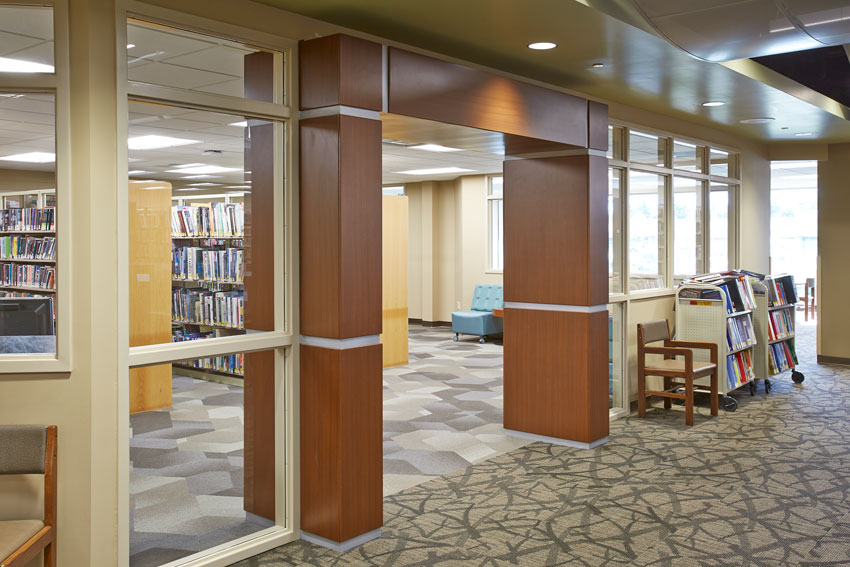
Photo courtesy of Inpro
Edge-wrapped protective wall panels allow for frameless installations using adhesive or z-clips for a clean, finished look.
Elevator Cabs
Many higher-education buildings have elevators, either because of accessibility/ADA requirements or for general circulation. Often, carts and equipment that are transported in an elevator can bang and bump against the interior of the cab. If the cab material isn’t durable, or if the general interior of the cab is outdated, then the appearance of the cab can cast a very negative impression on the people using it. That is why it is common to carry out an elevator cab upgrade either in conjunction with a larger general building renovation project or as a stand-alone project across several buildings.
The most cost-effective and innovative way to carry out such an elevator cab upgrade is to use a preconfigured elevator cab renovation system from a manufacturer that has a specialty line of products to address these needs. This system can include any or all of the following elements.
- New panels: The elevator panels that line the walls are what primarily make up the appearance of the cab. These panels also typically take quite a beating—from luggage carts, student resident move-ins and outs, construction equipment, vandalism, and whatever else may come their way. Fortunately, the panels can be made of durable and rugged materials that can be made to look like any range of materials from wood to metal to stone or custom choices.
- New ceilings and lighting: Elevator ceilings come in many different styles and can be selected to suit an overall design concept. Lighting in elevator cabs can be chosen from among common lamping options, such as halogen, incandescent, fluorescent, or energy-efficient LED. Keep in mind that people tend to be more comfortable in a well-lit interior, so combining a brighter ceiling with increased lighting output can help people feel more relaxed inside, not to mention create a newer and cleaner look. Further, selecting energy-efficient LED lighting means the lamps have a much longer service life, notably reducing maintenance costs for replacements.
- New handrails: Handrails in elevators may not get much attention unless ADA or accessibility code requirements are being looked at. The handrails not only provide stability for users (i.e., something to grasp) while the elevator stops and starts, but they also provide a means for a complete look to the cab and can act as a wall guard too. Providing a standoff surface from the wall of the cab can reduce the chance of equipment or furniture striking the wall panels.
Paying attention to both the appearance and durability of wall surfaces and elevator cabs can clearly pay off in terms of creating successful, innovative interiors in higher-education facilities.

Photo courtesy of Inpro
A $3.5-million renovation project to modernize multiple elevators across the campus of the University of North Carolina – Charlotte included multiple woodland patterns with custom graphic logos applied in selected locations, plus new stainless steel pan ceilings with LED downlights and stainless steel handrails.
Bathing Privacy
Dormitories, locker rooms, and some special use areas in higher-education facilities include showers for the use of students, faculty, or staff. For decades, the norm has been to provide communal or gang showers in situations like this. The concept made sense since multiple showering “stations” within a given space increased efficiency and capacity while reducing mechanical first costs in new construction. But, times and culture have changed. There are new norms about bathing privacy and transgender issues that have raised new concerns and challenges related to bathroom and shower design. Further, additional risks of serious bacterial infections for athletes and other users puts new focus on the design and surface cleanliness of communal shower installations.
One of the clearest drivers on the issue of bathing privacy in multi-occupant facilities has been the co-ed integration of housing at colleges and universities. Dr. Kathryn H. Anthony, Ph.D., is a distinguished professor in the School of Architecture at the University of Illinois at Urbana-Champaign. In a blog post on disadvantagedbydesign.com, she writes: “Communal bathrooms present many negative issues for their users. These facilities require users to enter with a “shower caddy” full of their toiletries needed for bathing. I personally was not too bothered by this arrangement while living in student housing, but it did present some obstacles that others strongly disliked. One of which is the fact that after your shower, unless you get fully dressed while still in the bathroom, which is made difficult by the wet floor and cramped stall, you must walk through a (usually) co-ed hallway in your towel to return to your dorm room. While this is fine for some people, others experience stress in this situation.” Dr. Anthony went on to say that several security breaches while living in the dorms meant greater risks on top of the discomfort some residents feel walking through co-ed hallways wrapped in a towel.
One answer for better personal comfort for the bather is to construct shower spaces with adequate dry-floor changing space that allows bathers to disrobe and get dressed within that space. In designs where space may not allow the combined shower and changing area, then a more inline approach with individual showering spaces can be used.
One example is seen in the Yocum Hall bathroom renovations at the University of Arkansas, part of a multiyear, campus-wide, multi-dorm updating project. The Yocum showers were redesigned with dry-floor changing space and solid surface partitions for privacy.
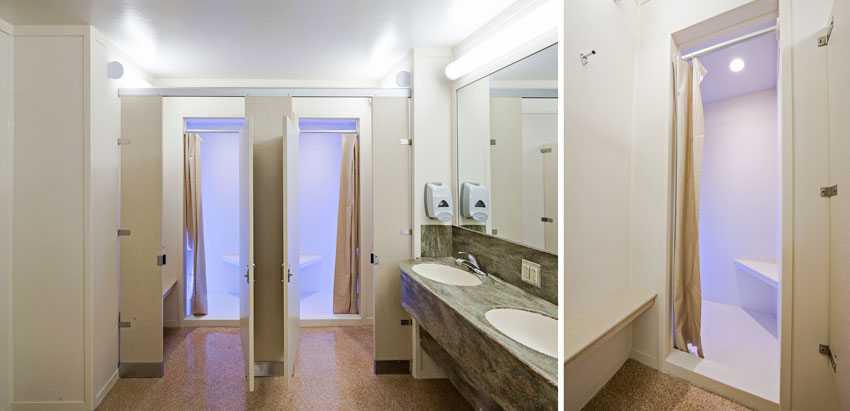
Photo courtesy of Inpro
Newly renovated bathrooms at Yocum Hall at the University of Arkansas feature a private, dry-floor changing space, allowing for greater bathing privacy and comfort for users.
A less obvious but potentially more troubling issue with communal showers is the potential spread of disease by bacteria building up on the surfaces. Methicillin-Resistant Staphylococcus Aureus (MRSA, pronounced “mer-sah”) is such a bacteria classed by the Centers for Disease Control (CDC) and the medical profession as one of the deadly “superbugs.” MRSA infections are extremely serious in that the bacteria have mutated resistance to some of the strongest antibiotics. In the worst case, the patient dies from the infection. Aside from the serious human health impact of MRSA, the economic and public relations aspects of such infections at a college or university can be staggering. The problem is so concerning that the CDC has an entire website dedicated to Cleaning and Disinfecting Athletic Facilities for MRSA (www.cdc.gov/mrsa/community/environment/athletic-facilities.html).
Among the guidelines, the CDC points out the issue with damaged surfaces that do not allow adequate cleaning. This recommendation raises a point that is often overlooked—broken tile and grout. It is a well-known fact that the grout between tiles can be a breeding ground for mold, mildew, and potentially bacteria due to the porous nature of the material. In a tile and grout shower surround, the porous grout is usually where the first black splotches of mold start growing. Where grout cracks or falls out, there is risk of water getting behind the tile, leading to tiles failing or moisture seeping into the gypsum board or other substrate. Cleaning and resealing tile means more work for maintenance staff and leaves room for error. Further, even if cleaned regularly, independent studies have demonstrated that bacteria are resilient and will rebound, often within hours of cleaning. For example, a study by Attaway et al (AJIC 40, 2012, 907–12) uncovered that surfaces cleaned with disinfecting solutions showed bacterial rebound within hours. Bottled disinfectant did reduce the average bacterial burden by 99 percent. However, the bacteria count rebounded to 30 percent of that found before disinfection by 6.5 hours after disinfection.
Experience with combatting bacteria, mold, and mildew has shown that one of the keys to effectiveness is the use of nonporous surfaces. Even better are surfaces that are specifically formulated not to promote the growth of mold or bacteria. Hence, many showers and bathrooms are now being designed with solid surface panels that are specifically manufactured for this purpose. Solid surface panels are an excellent choice as a shower enclosure material since they are non-nutritive, do not promote the growth of mold and mildew, and resist bacterial growth. They can be used on the vertical walls and sides of the showers and also be formed or manufactured for the floor, or receptor, of the shower. An integral nonskid surface can be incorporated to help prevent slips and falls, and ADA edges and ramps can ease the transition from floor to receptor. Drain locations can be set to match existing plumbing, and trench drains are also an option.
From a design standpoint, there are numerous color and pattern options, and ¼-inch or ½-inch sheets can be installed right over existing tile. S-curve (wavy) edges provide a good seal, and their fit maintains a flat, flush seam where the wall may fluctuate. In addition, large sheet sizes mean fewer seams where dirt can accumulate. Recessed soap dishes or soap shelves can be easily incorporated into the shower surround. During construction, the use of solid surface means quicker turnaround on installation over traditional tile. From start to cured finish, solid surface showers can be ready to use in as little as four to five days compared to traditional tile, which can take up to 12 days. For green construction projects, some manufacturers have created solid surface formulas containing rapidly renewable bio-based resins.
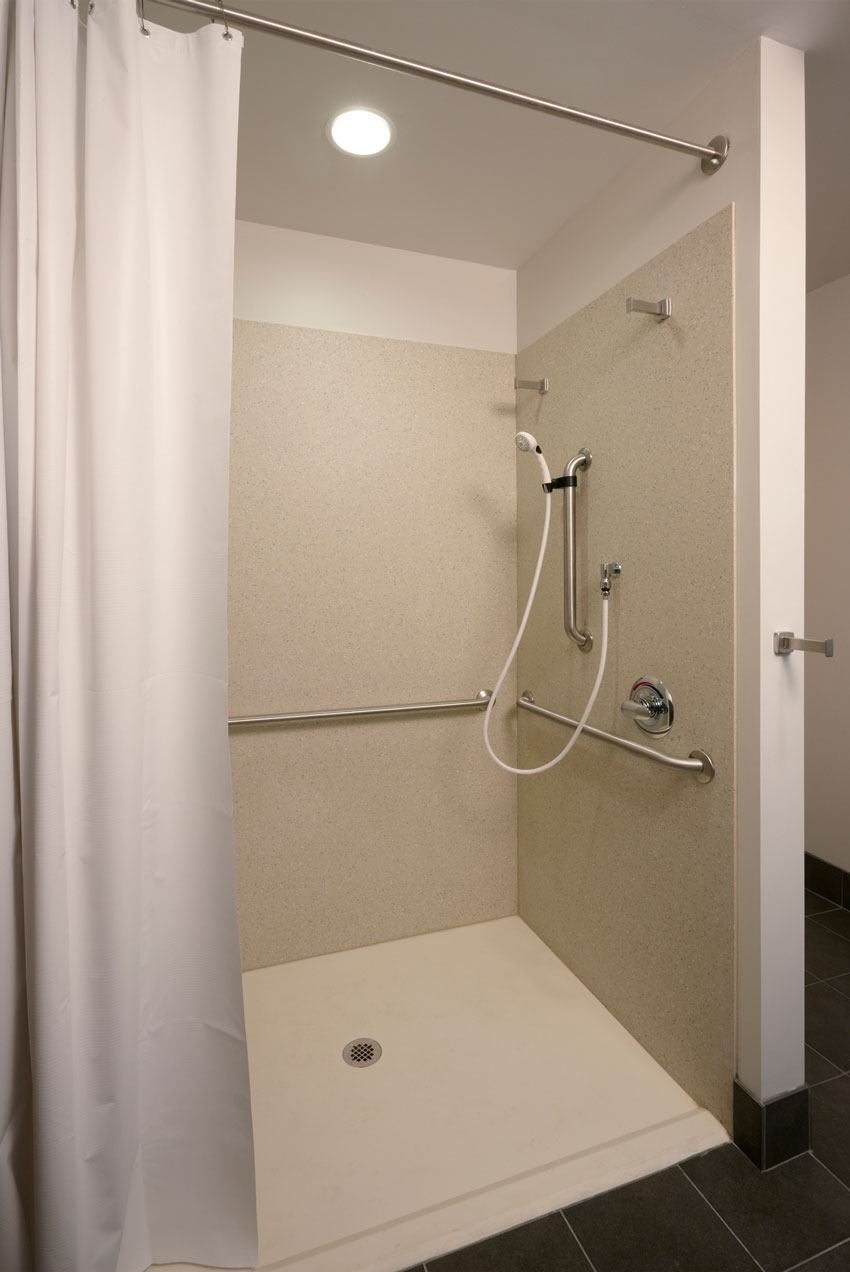
Photo courtesy of Inpro
Solid surface material can be used for the walls and floor, or receptor, of a public shower to help prevent the growth and spread of odor-causing bacteria, mold, and mildew.
Conclusion
Architects, interior designers, and other design professionals have the ability to create state-of-the art buildings and facilities in higher-education settings by working collaboratively with college and university staff. They can do this by bringing an understanding of different design options and the best use of materials or systems to improve both the exterior and interior building design and performance.
Peter J. Arsenault, FAIA, NCARB, LEED AP, is a practicing architect, green building consultant, continuing education presenter, and prolific author engaged nationwide in advancing building performance through better design. www.linkedin.com/in/pjaarch

